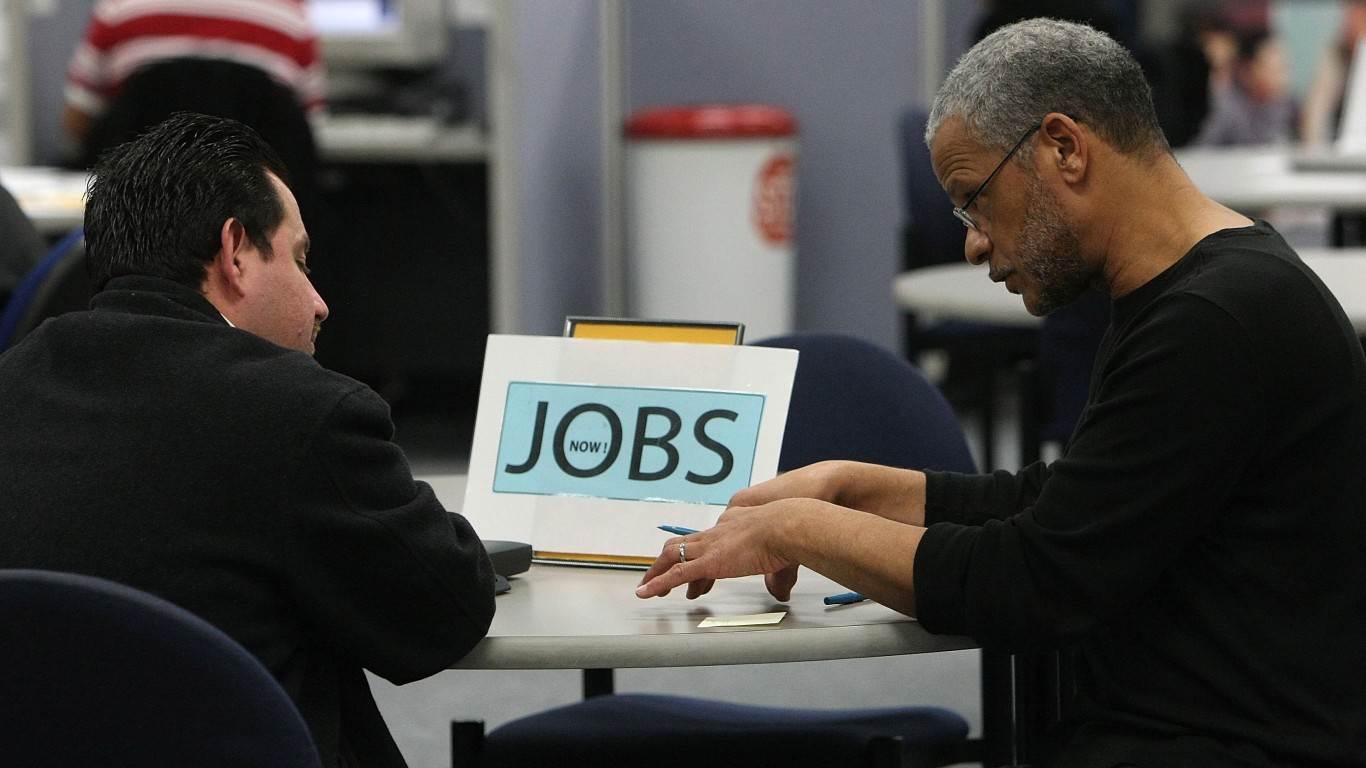
Incomes tend to rise with educational attainment in the United States. The latest data from the Bureau of Labor Statistics shows that the typical worker with no more than a high school diploma earns about $44,400 a year, compared to nearly $74,500 among bachelor’s degree holders. For workers with advanced degrees, salaries tend to be even higher.
Greater lifetime earning potential is a powerful incentive for pursuing a postgraduate degree. According to the U.S. Census Bureau, more than 23 million Americans have a master’s degree – and most of them who are working full time make over $86,000 a year. (These are the college majors most likely to earn six figure salaries.)
Of course, when it comes to graduate school, potential earnings are not the only consideration to weigh. Individual interests and aptitudes can also drive career decisions, and for many Americans, these factors are more important than income.
Using data from the U.S. Bureau of Labor Statistics, 24/7 Wall St. identified the lowest paying jobs that require a master’s degree. Occupations that typically require a master’s degree for entry were ranked based on median annual wage in 2022.
Among the 20 occupations on this list, the typical, full-time worker earns anywhere from $79,450 a year to $39,990 – or between about $6,800 and $46,400 less than the typical worker with a master’s degree. (Here is a look at the 25 lowest paying college majors.)
These jobs fall into one of four broad categories: life, physical, and social sciences; community and social services; educational instruction and library occupations; and health care practitioners and technical occupations. Many of them — including specific subsets of social work, counseling, and teaching fields — and are geared toward serving humanitarian causes and directly contribute to the greater good.
Jobs in the private sector tend to pay more than jobs within the government – and many of these occupations are concentrated in the public sector. Across all occupations, local, state, and federal government positions account for 14.5% of employment, according to the BLS. In three quarters of the jobs on this list, public sector employment exceeds the national average – including seven occupations where over 50% of the workforce are employed by the government.
Here are the lowest paying jobs that require a master’s degree.
20. Urban and Regional Planners

- Median annual wage: $79,540
- Total employment: 39,880
- Projected employment change, 2022 to 2032: +3.7%
- Employment by sector: Public 84.0%; private 16.0%
19. Epidemiologists

- Median annual wage: $78,520
- Total employment: 9,430
- Projected employment change, 2022 to 2032: +26.7%
- Employment by sector: Public 66.3%; private 33.7%
18. Postsecondary Art, Drama, and Music Teachers

- Median annual wage: $77,280
- Total employment: 97,830
- Projected employment change, 2022 to 2032: +3.2%
- Employment by sector: Public 49.0%; private 51.0%
17. Orthotists and Prosthetists

- Median annual wage: $77,070
- Total employment: 9,150
- Projected employment change, 2022 to 2032: +15.4%
- Employment by sector: Public 10.9%; private 89.1%
16. Acupuncturists

- Median annual wage: $72,220
- Total employment: 7,800
- Projected employment change, 2022 to 2032: +5.3%
- Employment by sector: Public 0.5%; private 99.5%
15. Instructional Coordinators

- Median annual wage: $66,490
- Total employment: 198,660
- Projected employment change, 2022 to 2032: +2.5%
- Employment by sector: Public 60.5%; private 39.5%
14. Historians

- Median annual wage: $64,540
- Total employment: 3,120
- Projected employment change, 2022 to 2032: +3.1%
- Employment by sector: Public 59.0%; private 41.0%
13. Anthropologists and Archeologists

- Median annual wage: $63,940
- Total employment: 7,350
- Projected employment change, 2022 to 2032: +4.2%
- Employment by sector: Public 32.9%; private 67.1%
12. Librarians and Media Collections Specialists

- Median annual wage: $61,660
- Total employment: 131,680
- Projected employment change, 2022 to 2032: +3.0%
- Employment by sector: Public 79.9%; private 20.1%
11. Survey Researchers

- Median annual wage: $60,410
- Total employment: 7,880
- Projected employment change, 2022 to 2032: -3.8%
- Employment by sector: Public 14.3%; private 85.7%
10. Curators

- Median annual wage: $60,380
- Total employment: 11,620
- Projected employment change, 2022 to 2032: +11.1%
- Employment by sector: Public 28.2%; private 71.8%
9. Healthcare Social Workers

- Median annual wage: $60,280
- Total employment: 182,420
- Projected employment change, 2022 to 2032: +9.6%
- Employment by sector: Public 13.8%; private 86.2%
8. Educational, Guidance, and Career Counselors and Advisors

- Median annual wage: $60,140
- Total employment: 308,000
- Projected employment change, 2022 to 2032: +5.4%
- Employment by sector: Public 69.4%; private 30.6%
7. Archivists

- Median annual wage: $58,640
- Total employment: 7,230
- Projected employment change, 2022 to 2032: +8.2%
- Employment by sector: Public 36.7%; private 63.3%
6. Marriage and Family Therapists

- Median annual wage: $56,570
- Total employment: 62,080
- Projected employment change, 2022 to 2032: +14.9%
- Employment by sector: Public 8.5%; private 91.5%
5. Athletic Trainers

- Median annual wage: $53,840
- Total employment: 29,720
- Projected employment change, 2022 to 2032: +14.1%
- Employment by sector: Public 25.7%; private 74.3%
4. Farm and Home Management Educators

- Median annual wage: $53,450
- Total employment: 8,220
- Projected employment change, 2022 to 2032: -2.0%
- Employment by sector: Public 90.0%; private 10.0%
3. Mental Health and Substance Abuse Social Workers

- Median annual wage: $51,240
- Total employment: 107,940
- Projected employment change, 2022 to 2032: +10.6%
- Employment by sector: Public 22.3%; private 77.7%
2. Counselors

- Median annual wage: $43,390
- Total employment: 37,270
- Projected employment change, 2022 to 2032: +17.2%
- Employment by sector: Public 19.9%; private 80.1%
1. Rehabilitation Counselors

- Median annual wage: $39,990
- Total employment: 82,420
- Projected employment change, 2022 to 2032: +1.9%
- Employment by sector: Public 25.1%; private 74.9%
Methodology
To determine the lowest paying jobs that require a master’s degree, 24/7 Wall St. reviewed data on median earnings and typical education requirements from the U.S. Bureau of Labor Statistics. Detailed occupations that typically require a master’s degree for entry were ranked based on median annual wage in 2022.
Data for typical education requirements for entry are from the BLS Employment Projections program, while data on median annual wage in 2022 is from the BLS Occupational Employment and Wage Statistics program. Supplemental data on total employment is from the BLS OEWS. Data on projected employment change from 2022 to 2032 is from the BLS EP.
It’s Your Money, Your Future—Own It (sponsor)
Retirement can be daunting, but it doesn’t need to be.
Imagine having an expert in your corner to help you with your financial goals. Someone to help you determine if you’re ahead, behind, or right on track. With SmartAsset, that’s not just a dream—it’s reality. This free tool connects you with pre-screened financial advisors who work in your best interests. It’s quick, it’s easy, so take the leap today and start planning smarter!
Don’t waste another minute; get started right here and help your retirement dreams become a retirement reality.
Thank you for reading! Have some feedback for us?
Contact the 24/7 Wall St. editorial team.



